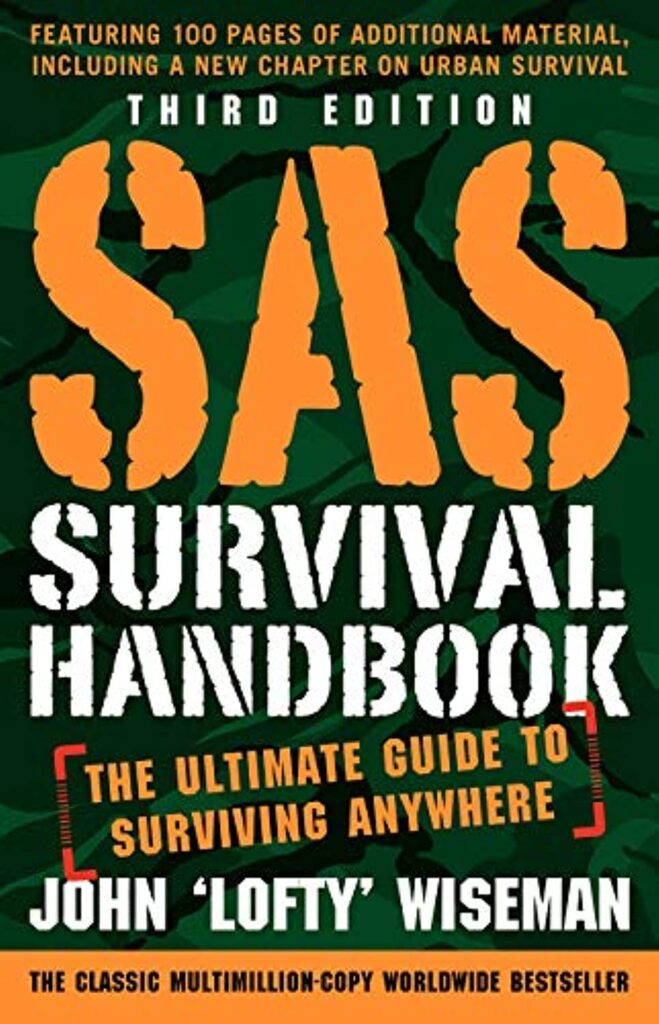“What would you do if you were suddenly stranded in the wilderness with nothing but your wits and a few basic tools?”
This is the essential question posed by John ‘Lofty’ Wiseman’s SAS Survival Handbook. A manual that is as much about mental resilience as it is about practical survival skills, this book is an indispensable guide for anyone serious about self-sufficiency and preparedness.
I remember my first camping trip with friends—our youthful confidence quickly turned to anxiety when we realized how ill-prepared we were for the unexpected. It was this experience that led me to explore survival literature, and ultimately, to discover the SAS Survival Handbook. This book has not only enhanced my survival skills but also instilled a sense of calm and confidence in the face of uncertainty.
A Comprehensive Survival Manual
The SAS Survival Handbook stands out in the crowded field of survival guides with its comprehensive coverage and practical insights drawn from Wiseman’s experiences with the British Special Air Service (SAS). The book is meticulously organized, offering detailed advice on a wide range of survival situations, from wilderness navigation and finding food and water, to first aid and surviving natural disasters.
Avoiding spoilers, it’s worth mentioning the book’s unique structure. Wiseman divides the content into clear, actionable sections, making it easy for readers to find the information they need quickly. Whether you’re looking to build a basic survival kit, learn advanced survival techniques, or understand the psychological aspects of survival, this handbook serves as a thorough and reliable resource.
Core Themes: Preparation, Adaptability, and Mental Toughness
Thematic Analysis: At its core, the SAS Survival Handbook emphasizes the importance of preparation, adaptability, and mental toughness. Wiseman underscores that survival is not just about physical skills but also about maintaining a positive mindset and staying calm under pressure. These themes are incredibly relevant in today’s unpredictable world, where natural disasters, economic uncertainties, and other crises can strike without warning.
Analyzing Wiseman’s Approach
Author’s Techniques: Wiseman’s writing is authoritative yet accessible. He uses a straightforward, no-nonsense style that reflects his military background, while also incorporating clear illustrations and step-by-step instructions that enhance the book’s practicality. The use of real-life scenarios and case studies adds depth and realism to the theoretical knowledge, making it easier for readers to visualize and understand the application of survival techniques.
How This Handbook Compares to Others
Comparative Analysis: Compared to other survival guides, the SAS Survival Handbook distinguishes itself through its breadth and depth. While many books in the genre focus on specific aspects of survival, Wiseman’s handbook covers the full spectrum, from urban survival to wilderness expeditions. It stands out for its thoroughness and the credibility of its author, whose extensive experience with the SAS provides a solid foundation for the advice given.
The Transformative Power of Survival Knowledge
Reading the SAS Survival Handbook was a transformative experience for me. The book’s detailed guidance on building a survival mindset resonated deeply, echoing my own experiences of overcoming challenges and learning the importance of mental resilience. The practical tips on emergency preparedness and resourcefulness have influenced my approach to both everyday situations and more extreme scenarios.
One section that particularly struck me was the discussion on the psychology of survival. Wiseman’s insights into maintaining morale and managing stress in life-threatening situations provided a new perspective on the importance of mental fortitude. This aspect of the book has had a lasting impact on my approach to both personal and professional challenges, reinforcing the idea that preparation is as much about mindset as it is about skills and equipment.
Reflect: Questions for Deeper Understanding
Reflection Questions:
- How do you think you would react in a survival situation? What steps would you take to stay calm and resourceful?
- What are the most critical survival skills you believe everyone should know? How prepared are you in these areas?
- How can the principles discussed in the SAS Survival Handbook be applied to everyday life challenges?
Multimedia: To enhance your understanding of the book, I recommend watching interviews with John ‘Lofty’ Wiseman, where he shares additional insights and stories from his career. There are also several online communities and forums dedicated to survival skills where you can discuss the book and exchange tips with fellow enthusiasts.
Urban Survival From SAS LEGEND | Lofty Wiseman:
The Power of Clear Expression
Wiseman’s writing in the SAS Survival Handbook is both clear and concise, making complex survival techniques accessible to beginners and valuable for experienced preppers. The active voice and varied sentence structure keep the reader engaged, while the practical advice is straightforward and easy to follow. This balance ensures that the book is not only informative but also enjoyable to read.
Further Reading
Contextual Information: John ‘Lofty’ Wiseman served in the British Special Air Service for 26 years, and his extensive experience in the field of survival is evident throughout the book. The handbook draws on his vast knowledge, offering readers a glimpse into the rigorous training and expertise of the SAS.
Further Reading: For those interested in expanding their survival knowledge, I recommend the following books:
- Bushcraft 101 by Dave Canterbury
- The Prepper’s Blueprint by Tess Pennington
- When All Hell Breaks Loose by Cody Lundin
These books complement the SAS Survival Handbook by offering additional perspectives and techniques that can enhance your preparedness efforts.
